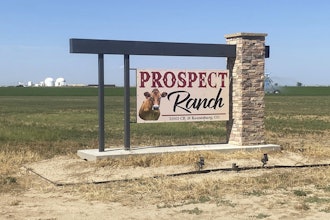
Yesterday, at the White House Water Summit, the National Science Foundation (NSF) joins other federal agencies to emphasize its commitment to a sustainable water future.
Access to affordable clean water is vital for energy generation, food cultivation and basic life support. With drought pressure and population demands, water is an increasingly precious resource.
The California drought and Flint water emergency show some of the consequences of clean water shortages. Low-cost, low-energy technologies for both water quality testing and water treatment must be developed to overcome economic barriers and secure America's future.
NSF supports national efforts to bolster water security and supply by investing in fundamental science and engineering research.
"Routine and reliable access to safe drinking water is one of the greatest achievements in human history, thanks to science and engineering research," said Pramod Khargonekar, NSF assistant director for Engineering. "To ensure this accessibility continues, contributions from all research areas -- from engineering and physical sciences to the biological and social sciences -- are essential. As such, NSF is uniquely positioned to advance water innovations."
For decades, NSF has funded researchers across disciplines to investigate fundamental water questions and propose novel solutions to challenges.
Despite the importance of water to life on Earth, major gaps exist in our understanding of water availability, quality and dynamics, as well as the impact of human activity and a changing climate on the water system. These gaps must be filled in order to create new concepts for water desalination, purification, reuse and treatments.
"To take on the most urgent challenge facing the world today, NSF and our partner agencies are funding researchers to explore interactions between the water system and land-use changes, the built environment, ecosystem functions and services, and climate change through place-based research and integrative models," said Roger Wakimoto, NSF assistant director for Geosciences. "Through these activities, we are enabling a new interdisciplinary paradigm in water research."
NSF-funded demonstrations at yesterday's White House event:
- An interactive augmented reality sandbox exhibit to help teach the public about watersheds, lake sciences, and environmental stewardship.
- The project, led by NSF-funded researcher Louise H. Kellogg, is a collaboration between university scientists and pubic science centers. Partners include University of California, the Davis W. M. Keck Center for Active Visualization in Earth Sciences, the Tahoe Environmental Research Center, the Lawrence Hall of Science, ECHO Lake Aquarium & Science Center, and Audience Viewpoints.
- A novel technology that uses sound waves to isolate and remove particles from fluids.
- Jason Dionne of FloDesign Sonics Inc. is supported by the NSF Small Business Innovation Research program to commercialize the technology, which offers a potentially more efficient and environmentally benign method to purify water.
- The launch of two "smart markets" for water leasing in the country: for groundwater trading in western Nebraska, and for surface-water trading in central Washington State.
- Mammoth Trading is creating smart markets to automate the process of checking complex regulatory rules for trading and to generate the highest economic gains among participants. By monetizing the value of conserved water, water leases generate a potential new revenue for water users and reward innovation in water use at the farm level. Mammoth Trading's markets will be available in over 500,000 acres of irrigated farmland. Mammoth Trading grew out of NSF-funded research, which was commercialized through the NSF Innovation Corps (I-Corps™) program.
- Mammoth Trading is creating smart markets to automate the process of checking complex regulatory rules for trading and to generate the highest economic gains among participants. By monetizing the value of conserved water, water leases generate a potential new revenue for water users and reward innovation in water use at the farm level. Mammoth Trading's markets will be available in over 500,000 acres of irrigated farmland. Mammoth Trading grew out of NSF-funded research, which was commercialized through the NSF Innovation Corps (I-Corps™) program.
- A book series and curriculum to teach children about the water cycle.
- NSF supports 25 Long-term Ecological Research (LTER) projects across the country and in Antarctica to study ecological processes. The LTER network enables these sites to serve as local and regional "schoolyards" to promote understanding of environmental processes among K-12 students. One outreach tool they employ is the LTER Schoolyard Series, which includes hands-on activity guides and integrates with federal and state science standards.
New NSF investments announced yesterday:
- $20 million to support cutting-edge water-research projects through the NSF Experimental Program to Stimulate Competitive Research program.
- Research teams will apply a systems-based, highly integrated approach to determine when and where the impacts of extreme events cascade through the combined social-ecological system. An integrated model of the watershed will be used to test management scenarios and identify strategies for maintaining infrastructure, environmental health and drinking water quality in the face of extreme weather events.
- Research teams will apply a systems-based, highly integrated approach to determine when and where the impacts of extreme events cascade through the combined social-ecological system. An integrated model of the watershed will be used to test management scenarios and identify strategies for maintaining infrastructure, environmental health and drinking water quality in the face of extreme weather events.
- $2 million to educate technicians for high-technology fields that drive our nation's economy through the NSF Advanced Technology Education program.
- A project to enhance marine and environmental science education at the five minority-serving community colleges of the Pacific Islands.
- American Samoa Community College, the College of Micronesia -- FSM, the College of the Marshall Islands, Northern Marianas College and Palau Community College will receive support for curriculum development, faculty professional development, internships and field experiences for students, and strengthened scientific infrastructure. Robert Richmond of University of Hawaii, Honolulu is the award's primary investigator.
- American Samoa Community College, the College of Micronesia -- FSM, the College of the Marshall Islands, Northern Marianas College and Palau Community College will receive support for curriculum development, faculty professional development, internships and field experiences for students, and strengthened scientific infrastructure. Robert Richmond of University of Hawaii, Honolulu is the award's primary investigator.
- A college course to increase student engagement and learning around the Hoosick Falls water crisis.
- The Village of Hoosick Falls in New York recently discovered unsafe concentrations of perfluorooctanoic acid in its public water system. With NSF support, an interdisciplinary group of scientists led by David Bond of Bennington College will develop a course to train students in the effective use of science and technology related to water safety.
- A project to enhance marine and environmental science education at the five minority-serving community colleges of the Pacific Islands.
- Two workshops planned on new water technologies and systems to give new meaning to the word "wastewater."
- Wastewater treatment plants are not only vital to the protection of human health and the environment, but also present opportunities to recover energy and other valuable resources -- creating a world-class water infrastructure while reducing the costs to run it. Recognizing this, NSF, the Department of Energy, the Environmental Protection Agency, and the U.S. Department of Agriculture, with the Water Environment Research Foundation, are developing a National Water Resource Recovery Test Bed Facility network and directory to connect researchers, new technology providers and other innovators in the water-resource recovery industry with test facilities appropriate for their needs. NSF is planning two workshops, in May and June 2016, to support the development of appropriate metrics and structure possibilities for the network.
- Wastewater treatment plants are not only vital to the protection of human health and the environment, but also present opportunities to recover energy and other valuable resources -- creating a world-class water infrastructure while reducing the costs to run it. Recognizing this, NSF, the Department of Energy, the Environmental Protection Agency, and the U.S. Department of Agriculture, with the Water Environment Research Foundation, are developing a National Water Resource Recovery Test Bed Facility network and directory to connect researchers, new technology providers and other innovators in the water-resource recovery industry with test facilities appropriate for their needs. NSF is planning two workshops, in May and June 2016, to support the development of appropriate metrics and structure possibilities for the network.
- A new Nanotechnology Signature Initiative on water sustainability through nanotechnology.
- Federal agencies participating in the National Nanotechnology Initiative will support a new initiative to focus on applying the unique properties of materials that occur at the nanoscale to increase water availability, improve water delivery and use efficiency, and enable next-generation water-monitoring systems. Participating agencies include the Department of Energy, the Environmental Protection Agency, NASA, the National Institute of Standards and Technology, NSF and the Department of Agriculture.
- Federal agencies participating in the National Nanotechnology Initiative will support a new initiative to focus on applying the unique properties of materials that occur at the nanoscale to increase water availability, improve water delivery and use efficiency, and enable next-generation water-monitoring systems. Participating agencies include the Department of Energy, the Environmental Protection Agency, NASA, the National Institute of Standards and Technology, NSF and the Department of Agriculture.
- A new video series to broaden awareness.
- The series will build on the popular 2013 Sustainability: Water episodes to explore how cutting-edge science and engineering research can transform how the country understands, designs and uses water resources and technologies. The videos will be produced by NBC Learn, the educational arm of NBCUniversal News Group, and will be shared in classrooms and with the public across a variety of platforms in the fall of 2016. The four-part series will promote public awareness of:
- Water resources, the variability of these resources, and water infrastructure designs and needs.
- Water conservation in rural and urban settings.
- Water treatment, including purification and desalination techniques.
- Water quality issues, including salinization and control.
- The series will build on the popular 2013 Sustainability: Water episodes to explore how cutting-edge science and engineering research can transform how the country understands, designs and uses water resources and technologies. The videos will be produced by NBC Learn, the educational arm of NBCUniversal News Group, and will be shared in classrooms and with the public across a variety of platforms in the fall of 2016. The four-part series will promote public awareness of:
- Innovative solutions from community college students at the nexus of food-water-energy.
- NSF and the American Association of Community Colleges have chosen 10 finalists in the second annual Community College Innovation Challenge, which calls on students enrolled in community colleges to propose innovative science, technology, engineering and mathematics (STEM)-based solutions to perplexing, real-world problems.
Significant ongoing NSF investments:
- Engineering Research Centers for responsible water use.
- The Engineering Research Center for Re-inventing the Nation's Urban Water Infrastructure (ReNUWIt), a research partnership among University of California, Berkeley, Colorado School of Mines, New Mexico State University and Stanford University, is facilitating the improvement of the nation's existing urban water systems through the development of innovative water technologies, management tools and systems-level analysis. This year, ReNUWIt will help advance urban water governance by releasing a set of decision-support tools that will allow utilities to quantify regional urban water resiliency and sustainability; promote the diversification of urban water supply portfolios by enabling virtual trading in regions with shared water resources; and support integrated management of water reuse and stormwater recharge systems.
- The Nanosystems Engineering Research Center for Nanotechnology Enabled Water Treatment Systems (NEWT), led by Rice University in partnership with Arizona State University, the University of Texas at El Paso and Yale University, is enabling off-grid drinking water. The NEWT Nanosystems ERC is pursuing high-performance and easy-to-deploy water treatment systems that can turn both wastewater and seawater into clean drinking water. The modular treatment systems, which will need less energy and fewer chemicals, will safely enlist the selective properties of reusable engineered nanomaterials to provide clean water at any location or scale.
- Ongoing grants to study the food-energy-water nexus.
- NSF has funded 17 grants, totaling $1.2 million, to support workshops on the interactions of food, energy and water, or FEW. Additionally, $6.4 million will supplement existing grants, enabling scientists to conduct additional research.
- NSF has funded 17 grants, totaling $1.2 million, to support workshops on the interactions of food, energy and water, or FEW. Additionally, $6.4 million will supplement existing grants, enabling scientists to conduct additional research.
- Ongoing grants to study water sustainability and climate.
- NSF and the U.S. Department of Agriculture's National Institute for Food and Agriculture have made three sets of awards, the latest totaling $25 million, in the joint Water Sustainability and Climate program. The funding fosters research on how Earth's water system is linked with climate change, land use and ecosystems.
- NSF and the U.S. Department of Agriculture's National Institute for Food and Agriculture have made three sets of awards, the latest totaling $25 million, in the joint Water Sustainability and Climate program. The funding fosters research on how Earth's water system is linked with climate change, land use and ecosystems.
- Special report on clean water technologies.
- Beyond the White House, NSF-funded clean water-related research activities are happening now across the country. Engineers improve lives every day by imagining and creating innovative new technologies and tools. Today, NSF launches a new special report on future engineering solutions for clean water: NSF.gov/water.
Join the conversation online with the hashtag #WHWaterSummit.






















